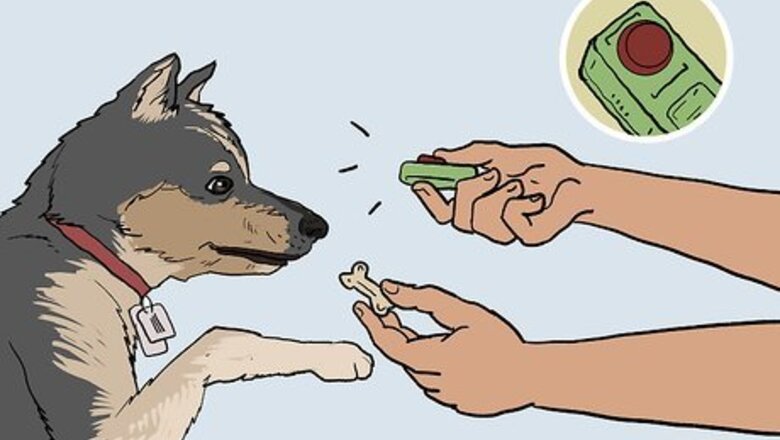
views
Learning Dog Training Basics

Pay attention to time. Teaching a dog to smile is similar to teaching him any habit, so you'll need to know the basic tenets of dog training. Timing makes a huge difference when it comes to successfully training a dog. A dog must be rewarded the instant he obeys a command. Many people reward their dogs with a small treat or positive verbal praise, such as "Yes!" or "Good job!" Some people invest in a clicker, a small mechanical device that makes a clicking noise when a button is pushed. You can teach your dog to associate the clicker with positive feedback by clicking it shortly before rewarding your dog with treats or attention.
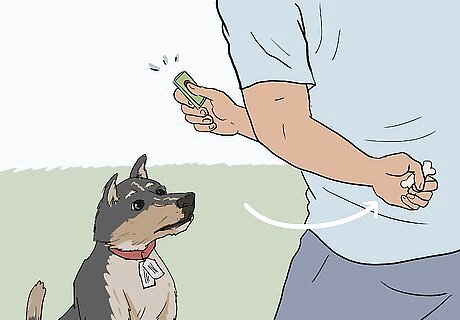
Differentiate between rewards and bribes. While treats as a reward can be great motivation for a dog, they begin to come off as bribes when used too often. This can result in the dog only engaging in behavior when he knows there's the possibility of food. Tell your dog to "smile." Wait 2 or 3 seconds for her to obey this command and only give her the treat if she does. Do not show her you have food until she's already done the trick. High energy dogs, particularly young dogs, may not want to engage in training sessions with you. If you're using treats as a way to lure them into the living room when practice time rolls around, stop. This teaches your dog she only has to behave well if food is involved.
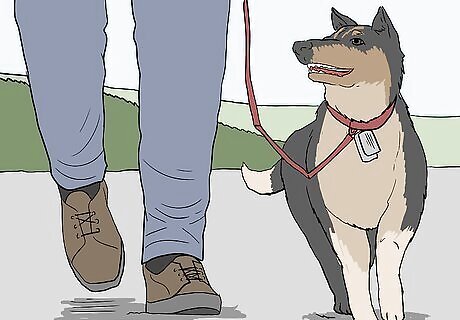
Use alternative rewards. Treats are many dog owners go-to, as they're a quick and easy way to reward a dog for positive behavior. You should mix up food-based rewards with other forms of positive feedback. If you have a playful dog, allow him access to a favorite toy for a few minutes shortly after smiling. Rewards like walks or car rides can be given out after a long training session. Dogs are natural people pleasers and want to make their owners happy. You can also reward your dog with pets and praise from you.

Use good posture and body cues. Dogs pick up on body language easily. While training, make sure to convey a sense of authority to your dog. Keep your hands out of your pockets. The dog might assume you have treats for him there and will learn he only needs to follow orders if food is a possibility. This can also distract him from the task. Keep your hands in view at all times. Never hold a bag of treats or a toy or any other objects used as a reward while training. Your dog needs to learn to behave regardless of potential rewards. Move from room to room during training. Dogs might assume they only have to engage in the behavior in one area of the house. Ideally, your dog should perform whenever you ask and not just in the living room or bedroom.
Rewarding Your Dog for Smiling
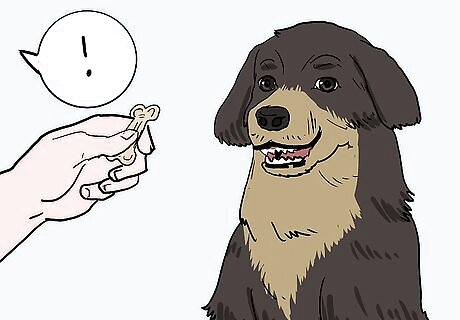
Watch for the behavior and reinforce it with a treat. Not all dogs smile. Some do, and this is called a submissive grin. If you see your dog do this, give them a treat. You'll know they get it when they start to make this face over and over again. At this point, use the verbal cue you want your dog to respond to just before they smile. For example, if you want your dog to smile when you say, "Say cheese!" use these words right before your dog shows their teeth and follow up with a reward.
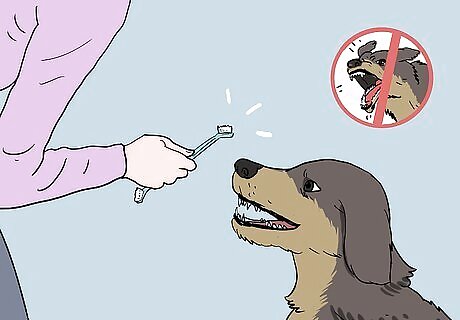
Find ways to get your dog to show his teeth. If you know your dog will show his teeth in particular occasions, take the opportunity to reinforce the behavior. Do you brush your dog's teeth regularly? Oftentimes, dogs show their teeth in anticipation of a toothbrush. You can take this as an opportunity to teach the dog to respond to your desired command. A small amount of dog-safe human food sometimes makes a dog show his teeth in confusion or due to distaste. This most often happens with bitter tasting foods, like fruits and veggies. However, be careful. Some fruits and vegetables, like grapes and tomatoes, are toxic to dogs. Make sure the food is safe before giving it to your pet. Never reward a dog if he show his teeth in aggression, however, and do not deliberately encourage aggressive behavior to get a dog to smile. This breeds hostility and can lead to bad behavior down the road.

Start training the dog to smile on cue. Once there is a firm connection established between the command and the behavior, you can begin solidifying this connection with proper training sessions. Offer words of encouragement while instructing your dog, and provide verbal and physical rewards as she responds to the command. Go over the command several times a day, doing 5 to 15 repetitions, until the dog seems to have mastered the behavior. Watch for new behaviors during training and take these as an opportunity to teach your dog new tricks. If, for example, your dog raises her paws forward while training you should immediately call out something like, "Beg!" and reward the dog.
Keeping Training Positive

Watch for signs of stress or aggression. If your dog begins showing signs of stress during training, you need to give him a break and evaluate your techniques. You want training to be a positive, bonding experience. Pay attention to the eyes. Dogs will squint when stressed, so if your dog's eyes look smaller than usual he might need a break. If your dog is staring at you without blinking or refusing to meet your gaze, these are signs of aggression. Your dog might be on the verge of an outburst and you should cease training until he's calmed down. The mouth, when closed, signifies tension and stress. A frightened dog will firmly close his mouth, and may flick his tongue in and out and lick his lips. Showing teeth is generally a sign of aggression, but as that's the behavior you're striving towards it's likely not the case unless accompanied by growling and/or the wrinkling of the muzzle. Raised, forward ears can indicate stress or aggression. If his ears are completely flattened against his skull, this indicates fright. These are both signs that training is not going well and your dog needs a break. When scared, a dog will do her best to look small. She may hunch over and lower her back, head, and tail. The tail might even be tucked between the legs. When a dog is using her full body to indicate fright, you are probably doing something wrong in training.
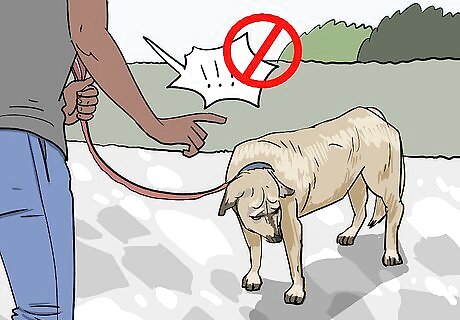
Avoid aversive techniques. Aversive training techniques essentially mean scolding or otherwise punishing your dog for negative behavior. Dogs trained using an aversive method are 15 times more likely to exhibit stress than dogs trained using positive reinforcement alone. Aversion techniques involve scolding the dog for negative behavior and sometimes use of devices like shock collars or choke chains to discourage negative responses. Dogs subjected to such methods show signs of stress more often during training sessions and seem to have less loving, positive overall relationships with their owners overall. Breaks are important. If a dog is not paying attention and showing signs of stress, he might simply need time to relax and be a dog. Behaviors like running, playing, and chewing should not be completely forbidden. Scolding in such instances will only serve to confuse and distress the dog.
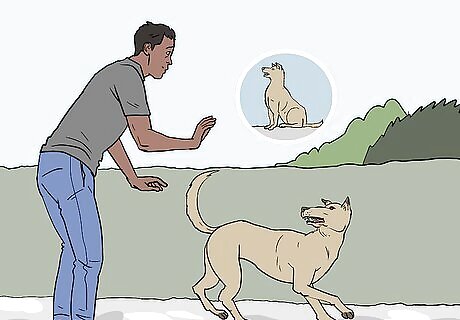
Engage in good leadership techniques. The alpha male approach is a myth of dog training, and can cause undue stress and aggression in dogs. While training, be a good leader but do not try to dominate your dog. The "alpha roll," which involves turning the dog on her side and holding her down, can be dangerous if done incorrectly and cause physical harm to the dog. It also leads to stress in dogs, which can turn aggressive fast. Refrain from such behaviors if your dog is getting antsy during training. Instead of attempting to dominate the dog, simply restrict access to rewards if a dog acts out. If your dog gets overexcited in the presence of treats, simply wait until she sits calmly before giving her any food. She will learn to engage in respectful behaviors when she realizes acting out does not result in a reward.
















Comments
0 comment